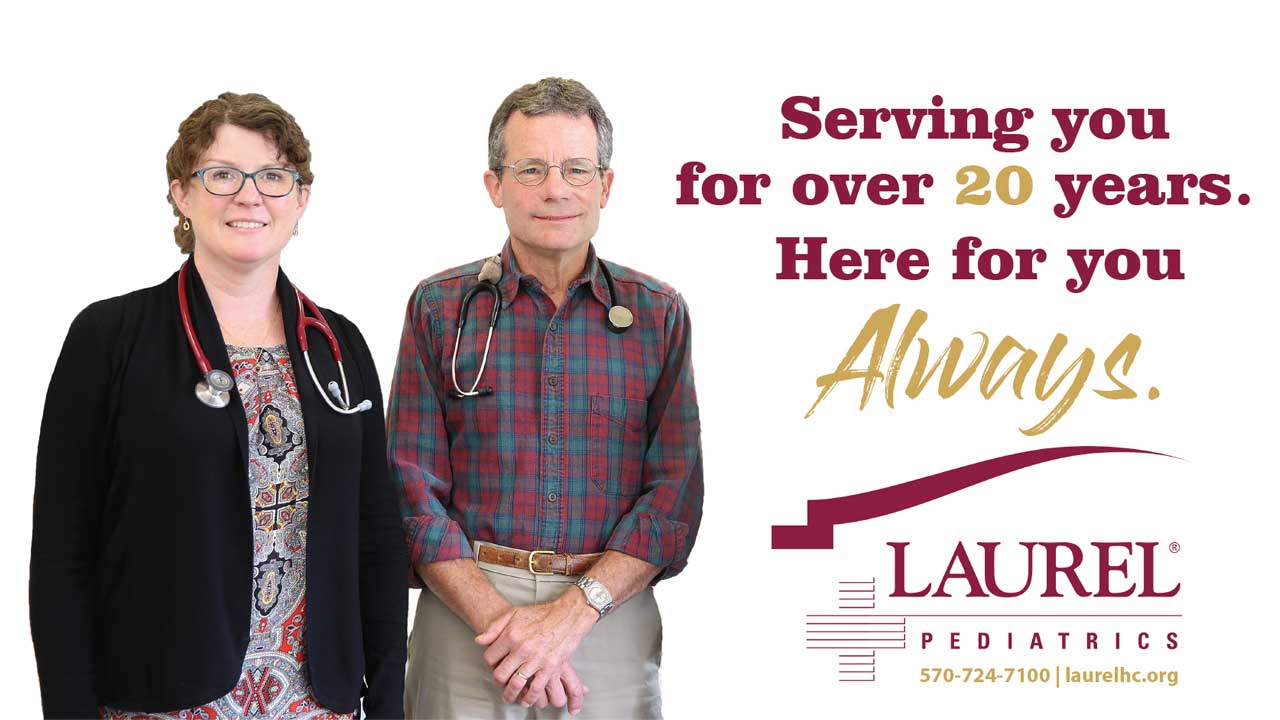Channels

Rotary

Rotary Conference

Laurel Health Centers

Penn Oak Realty

Movin Together

Bank On It

Dunhams Corner

By The Door

Questioning Life

Karschners Insurance

Ag Happenings

Back to Basics

Hornet Happenings

Live From The Hive

Momday Monday

Pennsylvania Politics

The Briefing

Weekly Highlights

Wellsboro Chamber

Tips for Masking Kids Safely & Effectively
This year’s back-to-school season is unlike any other as our community continues to face the challenges of Coronavirus COVID-19. Kids are required to wear face masks in school and in public, and Laurel Pediatrics realizes parents may have questions about how to do that effectively, particularly with young children. Below are some practical tips by age for masking your children safely and effectively.
WHY MASKING IS IMPORTANT
COVID-19 has a long incubation period, which means people can shed it before they show symptoms or in the case of asymptomatic carriers, without showing symptoms. This is especially true of children who may have mild symptoms that are easily missed. COVID-19 spreads mainly through droplets created when we speak, laugh, sneeze, cough, and breathe. Masks play an important role in keeping our community safe by reducing the likelihood of those droplets reaching the air and infecting others.
WHEN YOUR CHILDREN SHOULD MASK
Everyone over the age of two should mask in public settings like school, stores, supermarkets, and doctors’ offices. Do not mask infants or toddlers under age two, as their inability to fully communicate or remove a mask themselves can present choking hazards. If your child has a severe sensory condition or developmental disability that makes routine masking difficult, try to avoid situations or locations that require masking like crowded public areas as often as possible and consider distance learning or other special accommodations for schooling.
HOW TO HELP YOUR CHILD ADJUST
For many children, face masks are unfamiliar or associated only with a doctor’s office. They may have questions about why it’s important to wear them in school and out in public. Here are some tips for talking about masks with your kids and getting them on board with this important safety measure:
- Help children understand why masks help and how to wear them
- Normalize masks through play and practice
- Give kids choices in design to get them involved
- Opt for masks that are easy to wash and sized for your child
- Make mask wearing more comfortable: if your kids are bothered by the ear loops, try adding buttons or clips to hair ties, head bands, ribbons, hats, or glasses to loop onto instead
Sources like the CDC have helpful examples for illustrating how to properly mask and how masks work. Remember to keep explanations of COVID-19 age-appropriate to avoid overwhelming children. For young children, use a simple message like “wearing a mask helps keep our family and others safe and healthy” and repeat this statement consistently.
For older children and teens, empower them with accurate information about how masks help us manage COVID-19 and correct misinformation with facts from official sources like the CDC, the PA Department of Health, and your healthcare provider.
MASKING TIPS BY AGE – INFANTS & TODDLERS (UNDER AGE 2)
This age group should not yet wear masks, so focus instead on getting them used to seeing people wearing masks by wearing one yourself. This helps them see masks as familiar and part of your family’s typical routine.
YOUNG CHILDREN (2-5 YEAR OLDS)
Young children learn through play, so make masks fun and playful. Have kids play doctor and practice putting a mask on their favorite stuffed animal or doll. Get them comfortable with wearing a mask by wearing it during playtime and for short periods at home so they associate masks with their normal routine. Opt for colorful or patterned masks to help them express themselves and foster a sense of involvement / positivity.
KIDS & PRE-TEENS (6-12 YEAR OLDS)
At this stage, it’s important for children to understand why they’re being asked to do something. While keeping the conversation simple and age-appropriate, walk your child through what COVID-19 is and how masks help stop its spread. Your child may be eager to know what they can do to help. Activate your child’s desire to help out by explaining that they are being a helper to others like their classmates and grandparents by wearing a mask, washing their hands, and keeping their distance from others in public.
TEENAGERS & COLLEGE STUDENTS (13-21 YEAR OLDS)
As any parent of a teenager or young college student already knows, kids this age are fiercely independent. They don’t like being told to do anything, and they frequently feel misunderstood. Start by validating their feelings whether it’s annoyance, confusion, or concern and let them feel heard. From there, reiterate that everyone is in the same boat. Discuss why it’s important for everyone to wear a mask for this safety measure to be effective. It may help to remind them that this safety measure, when followed by the full community, allows their favorite stores, restaurants, and salons to stay safely open.
Take care to clear up any misunderstandings or misconceptions they may have picked up from social media or friends like “COVID-19 isn’t serious for kids my age” or “masks don’t really help.” Share that masks have been clinically proven to reduce transmission when worn correctly over the nose and mouth, and help kids understand that COVID-19 can affect anyone. While COVID-19 is less likely to cause severe symptoms or death in children without an underlying health condition, the risk is still there. Additionally, smoking or e-cigarette use (vaping) can significantly increase a teen or young adult’s risk of contracting and experiencing severe COVID-19 symptoms.
Have questions or concerns about how to keep your child safe throughout the school year? Laurel Pediatrics is here for you. Our expert pediatric team is dedicated to caring for all of your family’s health needs throughout the pandemic and beyond. For more information or to make an appointment, call Laurel Pediatrics at (570) 724-7100 today. To learn more, visit laurelhc.org.
Dr. Barry Clark is a local pediatrician with Laurel Pediatrics in Wellsboro and has been serving the Tioga County community for over 20 years. He specializes in pediatric health and wellness, treating patients aged newborn through 21. To make an appointment, call (570) 724-7100.
Credits:
Writing: Barry Clark, MD /
Pediatrician /
Laurel Pediatrics
Produced by Vogt Media
Home Page Sponsors: Laurel Health Centers






































